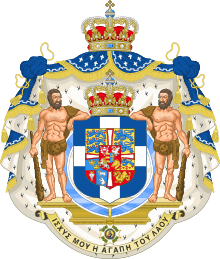Aspasia Manos
| Aspasia Manos | |
|---|---|
| Princess Alexander of Greece and Denmark | |
 | |
| Spouse | Alexander of Greece |
| Issue | Alexandra, Queen of Yugoslavia |
| Father | Petros Manos |
| Mother | Maria Argyropoulos |
| Born |
4 September 1896 Tatoi, Athens, Greece |
| Died |
7 August 1972 (aged 75) Ospedale Al Mare, Lido di Venezia, Italy |
| Burial | Royal Cemetery, Tatoi Palace, Greece |
| Religion | Greek Orthodox |
Aspasia Manos (Greek: Ασπασία Μάνου) (4 September 1896 – 7 August 1972), was a Greek commoner who became the wife of Alexander, King of the Hellenes. Due to the controversy over her marriage, she was styled Madame Manos rather than Queen Aspasia, until recognized as Princess Alexander of Greece and Denmark after Alexander's death and the restoration of King Constantine I.
Biography
Aspasia was born in Athens, the daughter of Colonel Petros Manos (1871–1918) and his first wife,[1] Maria Argyropoulos (1874–1930). The Manos family descended, in part, from Phanariote Greeks living in Constantinople. Some of her ancestors had been leaders during the Greek War of Independence, some had been Hellenic leaders in Constantinople for centuries under the Ottoman Empire, and some had even been reigning princes of Danubian provinces. She belonged to one of Greece's most aristocratic families, and was considered a suitable consort for a Greek king by some, but not by those who expected royalty to marry only royalty.
On 4 November 1919,[2] at Tatoi, Aspasia Manos married King Alexander in a secret, civil wedding.[3] Their marriage caused a scandal, and the couple was forced to temporarily flee to Paris. She never took the title of Queen, being known as Madame Manos by those aware of the marriage.[4] Alexander lived less than a year after the wedding. His father, King Constantine I, was restored to the Greek throne a month after Alexander's death and returned from exile. His government officially treated the brief reign of his late son as a regency, which meant that Alexander's marriage, contracted without his father's or the head of Orthodox Church's permission, was technically illegal, the marriage void, and the couple's posthumous child illegitimate.
At the behest of Alexander's mother, Queen Sophia, a law was passed in July 1922 which allowed the King to retroactively recognize marriages of members of the Royal Family, although on a non-dynastic basis.[4] Thereupon King Constantine issued a decree, gazetted 10 September 1922, recognizing the marriage of Alexander to Aspasia. Henceforth, she and her daughter were accorded the title "Princess of Greece and Denmark" and the style of Royal Highness.[5] This title was customarily borne by non-reigning members of the Greek royal family, who also happened to be members of a cadet branch of the reigning dynasty of Denmark.

Aspasia and Alexander were the parents of only one child, Princess Alexandra, born five months after Alexander's death at Tatoi (her father having died of sepsis following a monkey bite). Alexandra would later marry Peter II, King of Yugoslavia.
Aspasia Manos and her daughter were the only members of the Glücksburg dynasty, the Greek royal house, to be of Greek descent. Like most European royal families by the 20th century, the Glücksburgs' ancestry was exclusively German.
Due to the combination of her daughter and son-in-law's health problems, financially straitened circumstances and troubled marriage, Aspasia acted as guardian to her grandson Alexander, Crown Prince of Yugoslavia (born 1945).[6] She raised him mostly in England. Just a month before her death, Alexander married a Royal Franco-Brazilian, Princess Maria da Gloria of Orléans-Braganza.
She died in Venice on 7 August 1972,[5] and was initially interred at the cemetery of San Michele island near Venice. Her remains were later transferred to the Royal Cemetery Plot in the park of Tatoi near Dekeleia (23 km north of Athens.)
Her living descendants include her only grandson Alexander, Crown Prince of Yugoslavia, and her three great-grandsons Prince Peter of Yugoslavia, Prince Philip of Yugoslavia and Prince Alexander of Yugoslavia.
Ancestry
| Ancestors of Aspasia Manos | ||||||||||||||||||||||||||||||||||||||||||||||||||||||||||||||||||||||||||||||||||||||||||||||||||||||||||||||||||||||||||||||||||||||||||||||||||||||||||||||||||||||||||||||||||||||||||||||||||||||||||||||||||||||||||||||||||||||||||||||||||||||||||||||||||||||||||||||||||||||||||||||||||||||||||||||||||||||||||||||||||||||||||||||||||||||||||||||||||||||||||||||||||||||||||||||||||||||||||||||||||||||||||||||||||||||||||||||||||||||||||||||||||||||||||||||||||||||||||||||||||||||||||||||||||||||||||||||||||
|---|---|---|---|---|---|---|---|---|---|---|---|---|---|---|---|---|---|---|---|---|---|---|---|---|---|---|---|---|---|---|---|---|---|---|---|---|---|---|---|---|---|---|---|---|---|---|---|---|---|---|---|---|---|---|---|---|---|---|---|---|---|---|---|---|---|---|---|---|---|---|---|---|---|---|---|---|---|---|---|---|---|---|---|---|---|---|---|---|---|---|---|---|---|---|---|---|---|---|---|---|---|---|---|---|---|---|---|---|---|---|---|---|---|---|---|---|---|---|---|---|---|---|---|---|---|---|---|---|---|---|---|---|---|---|---|---|---|---|---|---|---|---|---|---|---|---|---|---|---|---|---|---|---|---|---|---|---|---|---|---|---|---|---|---|---|---|---|---|---|---|---|---|---|---|---|---|---|---|---|---|---|---|---|---|---|---|---|---|---|---|---|---|---|---|---|---|---|---|---|---|---|---|---|---|---|---|---|---|---|---|---|---|---|---|---|---|---|---|---|---|---|---|---|---|---|---|---|---|---|---|---|---|---|---|---|---|---|---|---|---|---|---|---|---|---|---|---|---|---|---|---|---|---|---|---|---|---|---|---|---|---|---|---|---|---|---|---|---|---|---|---|---|---|---|---|---|---|---|---|---|---|---|---|---|---|---|---|---|---|---|---|---|---|---|---|---|---|---|---|---|---|---|---|---|---|---|---|---|---|---|---|---|---|---|---|---|---|---|---|---|---|---|---|---|---|---|---|---|---|---|---|---|---|---|---|---|---|---|---|---|---|---|---|---|---|---|---|---|---|---|---|---|---|---|---|---|---|---|---|---|---|---|---|---|---|---|---|---|---|---|---|---|---|---|---|---|---|---|---|---|---|---|---|---|---|---|---|---|---|---|---|---|---|---|---|---|---|---|---|---|---|---|---|---|---|---|---|---|---|---|---|---|---|---|---|---|---|---|---|---|---|---|---|---|---|---|---|---|---|---|---|---|---|---|---|---|---|---|---|---|---|---|---|---|---|---|---|---|---|---|---|---|---|---|---|---|---|---|---|---|---|---|---|---|---|---|---|---|---|---|---|---|---|---|---|---|---|---|---|---|---|---|---|---|---|---|---|---|---|---|---|---|---|---|---|---|---|---|---|---|---|---|---|---|---|---|---|---|---|---|---|---|---|---|
| ||||||||||||||||||||||||||||||||||||||||||||||||||||||||||||||||||||||||||||||||||||||||||||||||||||||||||||||||||||||||||||||||||||||||||||||||||||||||||||||||||||||||||||||||||||||||||||||||||||||||||||||||||||||||||||||||||||||||||||||||||||||||||||||||||||||||||||||||||||||||||||||||||||||||||||||||||||||||||||||||||||||||||||||||||||||||||||||||||||||||||||||||||||||||||||||||||||||||||||||||||||||||||||||||||||||||||||||||||||||||||||||||||||||||||||||||||||||||||||||||||||||||||||||||||||||||||||||||||
References
- ↑ Manos family
- ↑ 17 November in the New Style Gregorian calendar
- ↑ Hueck, Walter von, ed. (1987). Genealogisches Handbuch des Adels Fürstliche Häuser Band XIII (in German). Limburg an der Lahn: C. A. Starke. p. 33.
- ↑ 4.0 4.1 Diesbach, Ghislain de (1967). Secrets of the Gotha. translated from the French by Margaret Crosland. London: Chapman & Hall. p. 225.
- ↑ 5.0 5.1 Montgomery-Massingberd, Hugh, ed. (1973). Burke's Guide to the Royal Family 1. London: Burke's Peerage. p. 327. ISBN 0-220-66222-3.
- ↑ Diesbach, Ghislain de (1967). Secrets of the Gotha. translated from the French by Margaret Crosland. London: Chapman & Hall. p. 337.
| Preceded by Sophia of Prussia |
Consort of the King of the Hellenes 4 November 1919 – 25 October 1920 |
Succeeded by Sophia of Prussia |
| |||||||||||||||||||||||||||||
| ||||||||||||||||||||||||||||||||||||||||||||||||||||||||||||||
| ||||||||||

